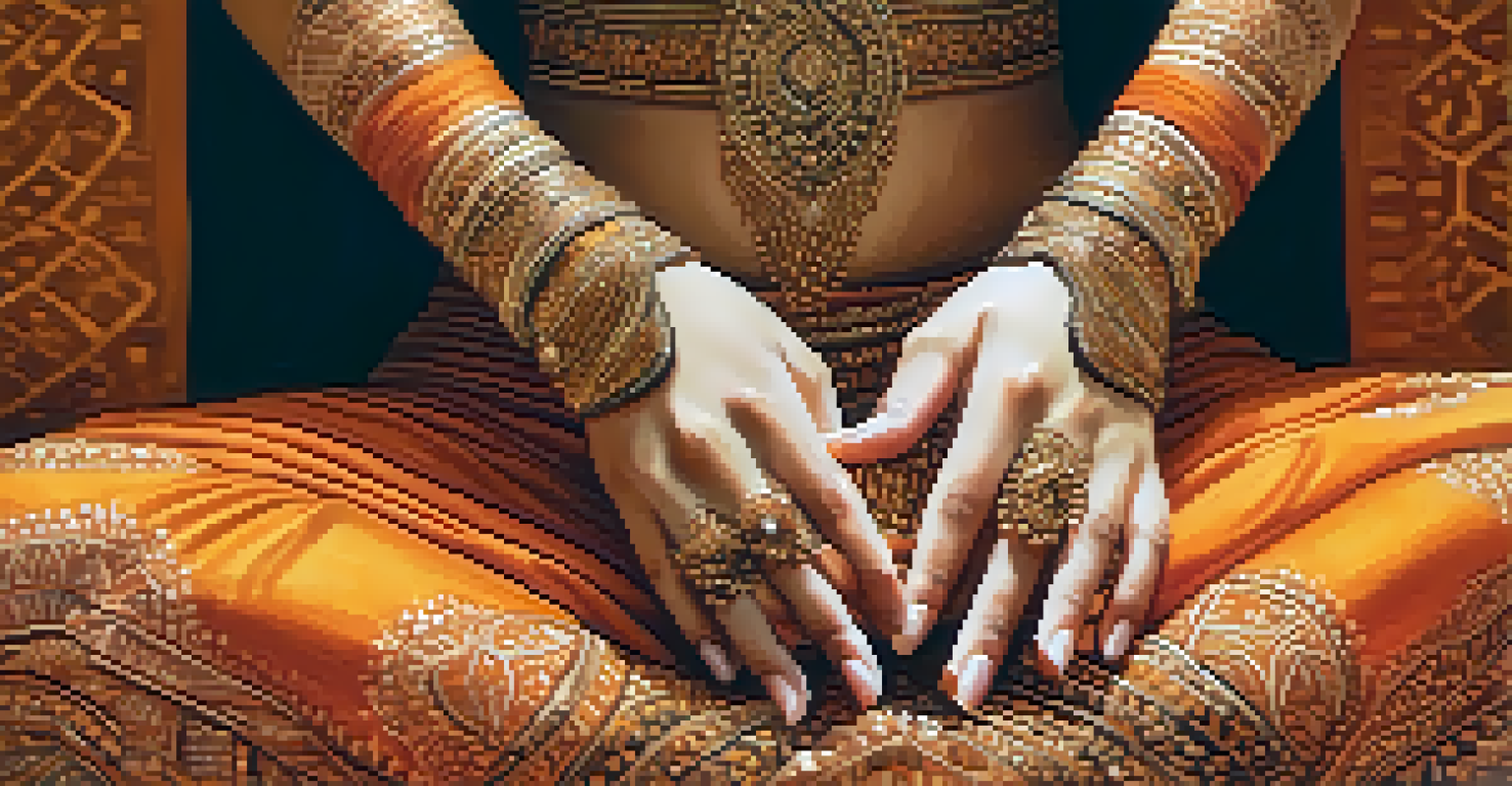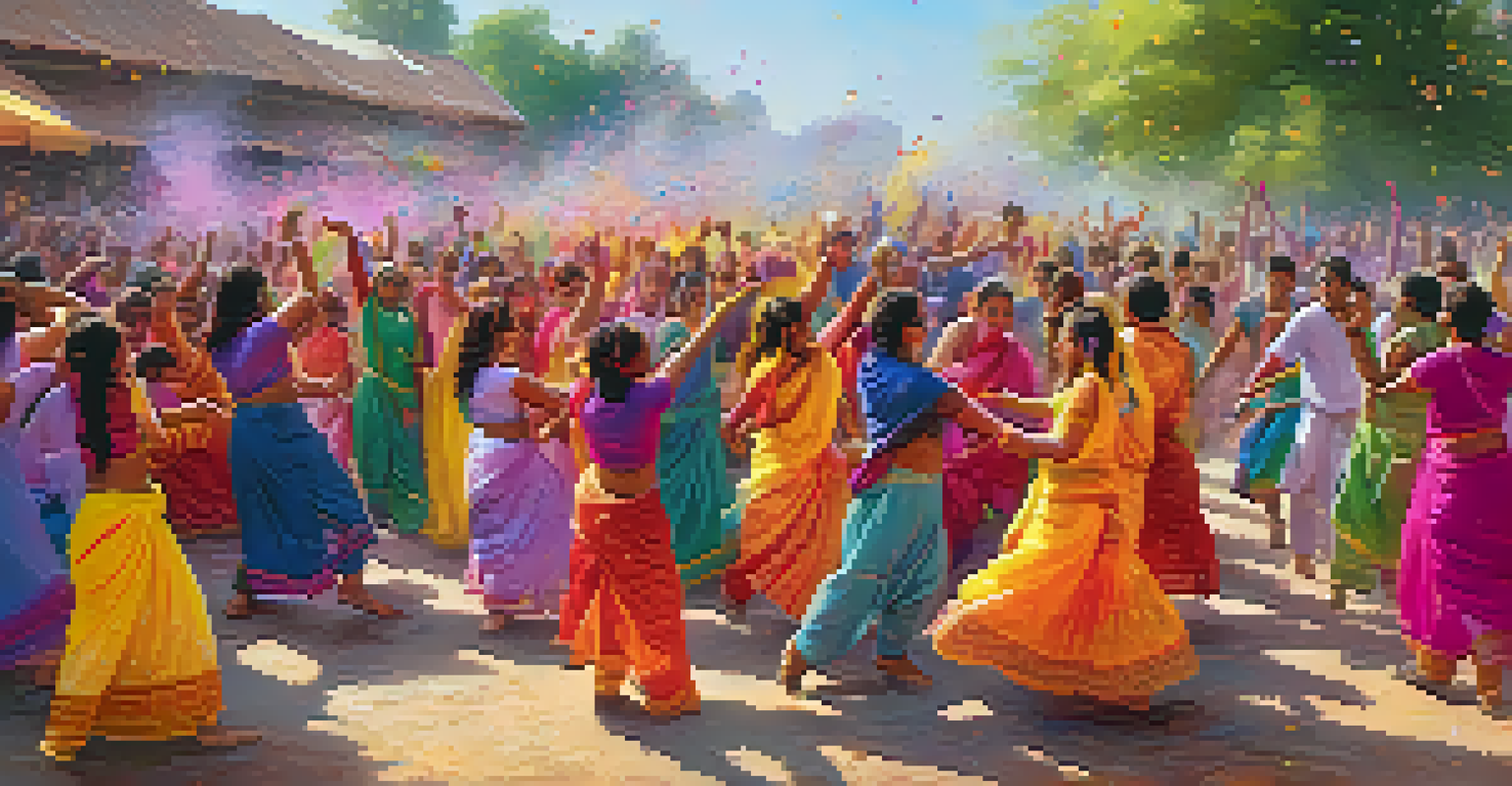The Role of Dance in Hindu Religious Festivals and Rituals

The Cultural Significance of Dance in Hinduism
Dance in Hinduism is more than just an art form; it embodies cultural traditions and spiritual beliefs. Celebrated as a divine expression, it connects devotees with the divine, enhancing their spiritual experience. Whether through classical forms like Bharatanatyam or folk dances, each style carries its own significance, reflecting the community's values and stories.
Dance is the hidden language of the soul.
In many Hindu festivals, dance serves as a medium of storytelling, where performers narrate mythological tales that resonate with the audience. For instance, during Navaratri, the Garba and Dandiya Raas dances celebrate the goddess Durga, showcasing devotion through rhythm and movement. These performances not only entertain but also educate participants about their heritage and beliefs.
Furthermore, dance acts as a communal activity that fosters unity and belonging among participants. It brings people together, regardless of age or background, creating a shared experience that strengthens community ties. In this way, dance transcends individual expression, becoming a collective celebration of faith and culture.
Dance as a Form of Worship in Rituals
In Hindu rituals, dance often plays a crucial role in worship, acting as an offering to deities. This sacred form of expression transforms the mundane into the divine, allowing devotees to connect more deeply with their spirituality. For example, the traditional dance performed during temple ceremonies is seen as a way to invite the presence of gods and goddesses.

The choreography and music used in these rituals are meticulously designed to align with the spiritual significance of the occasion. Each movement and gesture, known as 'mudras,' conveys specific meanings that resonate with the themes of devotion and reverence. This intentionality elevates the dance from mere performance to a sacred act of worship.
Dance as Spiritual Expression
Dance in Hinduism serves as a divine form of worship, connecting devotees to the spiritual realm through movement and ritual.
Moreover, participating in these dances can be a transformative experience for the worshippers. It allows them to express their devotion physically, creating a sense of transcendence that deepens their faith. In this way, dance becomes a vital component of the spiritual journey, merging art with devotion.
Festivals: A Showcase of Dance Traditions
Hindu festivals are vibrant celebrations where dance takes center stage, showcasing a rich tapestry of traditions. Events like Diwali, Holi, and Pongal feature various dance forms that reflect the unique cultural heritage of different regions. Each festival has its own distinct dances that tell stories and celebrate the triumph of good over evil.
The body says what words cannot.
For instance, during the festival of Holi, playful and energetic dances bring communities together in a celebration of color and joy. These dances often involve spontaneous movements, echoing the spirit of the festival. Similarly, during Diwali, classical dances may be performed to narrate the epic tales of Lord Rama, enhancing the festive atmosphere with cultural significance.
The performances during these festivals not only entertain but also serve to preserve and pass down traditions to future generations. Through dance, the essence of Hindu culture is kept alive, allowing younger generations to connect with their roots while celebrating their identity.
Dance Forms Unique to Regional Festivals
India's diverse cultural landscape means that each region has its own unique dance forms associated with local festivals. For example, the 'Bhangra' dance from Punjab is a lively celebration during harvest festivals, embodying the joy of abundance and community spirit. Similarly, the 'Kuchipudi' dance from Andhra Pradesh often features themes from mythology, performed during temple festivals.
These regional dances are not only expressions of joy but also reflect the history and traditions of the communities. Each dance form carries with it the stories, costumes, and music of its people, making festivals vibrant and culturally rich experiences. This regional diversity adds layers of meaning to the celebrations, fostering a sense of pride and continuity.
Festivals Celebrate Cultural Heritage
Hindu festivals prominently feature various dance forms that reflect regional traditions and tell stories, enriching the cultural tapestry.
By participating in these regional dances, individuals not only celebrate their heritage but also create a sense of belonging. It allows them to engage with their culture actively, promoting a deeper understanding and appreciation of their roots within the larger tapestry of Hinduism.
Dance as a Medium for Social Commentary
Interestingly, dance in Hindu festivals can also serve as a form of social commentary, addressing contemporary issues while honoring tradition. Performers often use their art to reflect societal values and challenges, creating a space for reflection and dialogue. This blend of tradition and modernity can be seen in various folk dances that highlight themes of social justice and equality.
For instance, some performances during festivals may incorporate contemporary issues such as women's empowerment or environmental sustainability, resonating with audiences on multiple levels. By doing so, dance becomes a powerful tool for awareness and change, while still remaining rooted in cultural practices. This approach encourages viewers to consider their roles in society while celebrating their heritage.
Through this lens, dance transcends its traditional role, evolving into a platform for expression that encourages community engagement. It invites participants and audiences alike to reflect on their beliefs and values, fostering a sense of responsibility towards their society while celebrating the richness of their culture.
The Therapeutic Aspects of Dance in Rituals
Beyond its cultural and spiritual significance, dance during Hindu festivals can have therapeutic effects on individuals. The act of dancing releases endorphins, promoting feelings of joy and well-being, which is especially important during communal celebrations. This emotional upliftment can enhance the overall festival experience, allowing individuals to connect more deeply with the festivities.
Moreover, participating in dance can serve as a form of stress relief, allowing individuals to express emotions that may be difficult to articulate. In the context of rituals, this cathartic release can lead to a greater sense of inner peace and spiritual connection. It encourages individuals to let go of their worries and immerse themselves in the celebration of life and devotion.
Dance as Social Commentary
Dance also addresses contemporary social issues, using traditional performances as a platform for dialogue and reflection.
As people come together to dance, the shared experience fosters a sense of community and belonging. This collective joy can enhance social bonds, creating lasting memories that resonate far beyond the festival. In this way, dance reinforces the communal spirit of Hindu festivals, promoting not only individual well-being but also a sense of unity.
Conclusion: The Enduring Power of Dance in Hinduism
In conclusion, dance plays a multifaceted role in Hindu religious festivals and rituals, enriching them with cultural significance and spiritual depth. From acting as a form of worship to serving as a medium for social commentary, dance embodies the essence of Hindu traditions. It not only preserves cultural heritage but also adapts to contemporary societal issues, making it a dynamic aspect of spiritual life.
As festivals continue to evolve, the role of dance remains pivotal in fostering community bonds and individual expression. It allows people to connect with their roots while embracing the future, ensuring that the spirit of Hinduism thrives. Moreover, the therapeutic benefits of dance enhance the overall experience, making each celebration an opportunity for joy and reflection.

Ultimately, dance in Hinduism is a celebration of life itself, intertwining faith, culture, and community. It invites everyone to partake in a journey that transcends the ordinary, creating a vibrant tapestry of experiences that honor the divine and celebrate the human spirit.